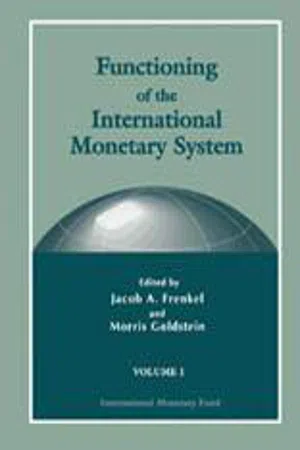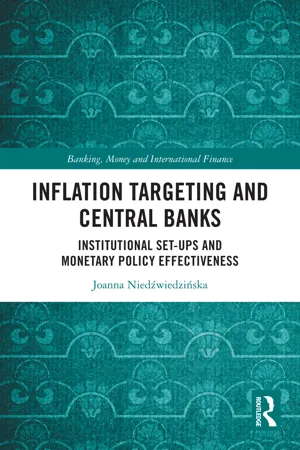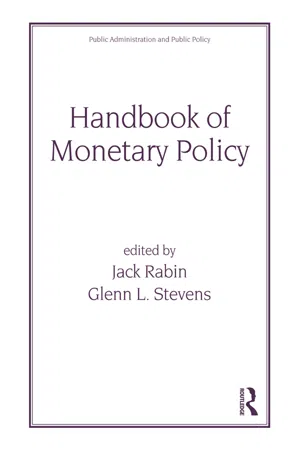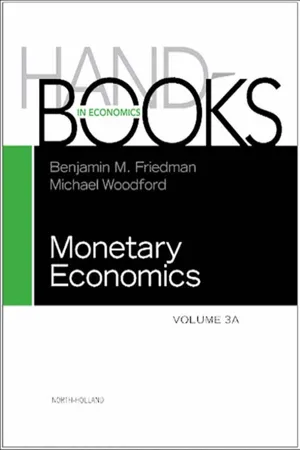Economics
Nominal GDP Targeting
Nominal GDP targeting is an economic policy strategy where a central bank sets a specific target for the nominal GDP growth rate. This approach aims to stabilize the economy by adjusting monetary policy to achieve the desired GDP growth rate. By focusing on nominal GDP, which includes both real output and price level changes, policymakers can address both inflation and economic growth.
Written by Perlego with AI-assistance
Related key terms
Related key terms
1 of 4
Related key terms
1 of 3
8 Key excerpts on "Nominal GDP Targeting"
- eBook - ePub
Accelerated Land Reform, Mining, Growth, Unemployment and Inequality in South Africa
A Case for Bold Supply Side Policy Interventions
- Nombulelo Gumata, Eliphas Ndou(Authors)
- 2020(Publication Date)
- Palgrave Macmillan(Publisher)
https://www.stlouisfed.org/publications/regional-economist/second-quarter-2019/bullard-nominal-gdp-targeting?Creamer, K., and Botha, T.R. 2017. Assessing Nominal GDP Targeting in the South African Context. Central Bank Review , 17(1), March 2017, 1–10. https://www.sciencedirect.com/science/article/pii/S1303070116300506?via%3Dihub .Du Plessis, S., and Rietveld, M. 2013. Should Inflation Targeting be Abandoned in Favour of Nominal Income Targeting? University of Stellenbosch Economic Working Papers: 12/13.Frankel, J. 1995. The Stabilizing Properties of a Nominal GNP Rule. Journal of Money, Credit and Banking , 27(2), 318–34.Frankel, J. 2012. Central Banks Can Phase in Nominal GDP Targets without Damaging the Inflation Anchor. VoxEU , December 19.Frankel, J. 2013. Nominal GDP Targets without Losing the Inflation Anchor. In L. Reichlin and R. Baldwin (eds.), Is Inflation Targeting Dead: Central Banking after the Crisis . Centre for Economic Policy Research: London, pp. 90–94.Frankel, J. The Case for (and Drawbacks of) Nominal GDP Targets. Capital Formation and Growth . Harvard Kennedy School, Harvard University. https://www.brookings.edu/wp-content/uploads/2017/12/frankel-slides.pdf .Hassan, S, and Loewald, C. 2013. Nominal GDP Targeting and the Monetary Policy Framework . South African Reserve Bank Working Paper WP 1305.- Hatzius, J. 2011. The Case for a Nominal GDP Level Target. US Economics Analyst, Goldman Sachs Global ECS Research, October.
Hoelle, M., and Peiris, U. 2013. On the Efficiency of Nominal GDP Targeting in a Large Open Economy . Krannert Working Paper Series, Paper No. 1273.Summers, H., Wessel, D., and Murray, J.D. 2018. Rethinking the Fed’s 2 per cent Inflation Target: A Report from the Hutchins Center on Fiscal and Monetary Policy at Brookings. https://www.brookings.edu/wp-content/uploads/2018/06/ES_20180607_Hutchins-FedInflationTarget.pdf - eBook - ePub
- Jacob Frenkel, and Morris Goldstein(Authors)
- 1996(Publication Date)
- INTERNATIONAL MONETARY FUND(Publisher)
III. Alternative Policy Rules
The policy rules that we consider in this paper fall into three groups. The first group is characterized by uncoordinated monetary policies and freely flexible exchange rates. The rules that are compared are money targeting and nominal GNP targeting. The second group encompasses two rules that use monetary policy to limit the flexibility of exchange rates. The first rule is a Bretton-Woods-like regime of nominal exchange rate parities; the second rule is a target zone plan that targets a real effective exchange rate. Whereas the first two groups of rules have assumed that fiscal policy is exogenous, the third group contains rules that use both monetary and fiscal policy to hit domestic and external variables.Uncoordinated Rules: Money Versus Nominal Income Targeting
During the 1970s, many central banks moved from a more discretionary monetary policy to explicit targets for monetary aggregates. Money targeting was seen as a way of avoiding destabilizing fine-tuning, and of counteracting the alleged bias of central banks to aim for more-than-full employment. In a well-known article, Poole (1970) showed that in the face of shocks to the investment-saving (IS) curve, stabilizing the nominal money supply stabilizes output. In contrast, if shocks are primarily to money demand, the appropriate policy is to accommodate them and to stabilize interest rates.The widespread evidence that money demand had shifted in the early 1980s as a result of financial innovations and of deregulation led to disenchantment with monetary targeting. Concern for the inflationary consequences of pegging interest rates led to a search for another nominal indicator that could serve as an intermediate target. Tobin (1980) argued that nominal GNP had several advantages over monetary aggregates: it was less sensitive to the shocks facing money demand, and it was not affected by the positive relationship between velocity and the nominal interest rate. The latter feature of money demand could lead to a fall , rather than a rise, in real interest rates in the face of an inflationary shock. The disadvantage of nominal GNP targeting, however, is that hitting a preset nominal GNP path exactly implies a linear, one-for-one trade-off between changes in the price level and output (Fischer (1988 - eBook - ePub
Inflation Targeting and Central Banks
Institutional Set-ups and Monetary Policy Effectiveness
- Joanna Niedźwiedzińska(Author)
- 2021(Publication Date)
- Routledge(Publisher)
At the same time, recognising the fact that inflation targeting was introduced as a framework to fight too high inflation, some economists have raised doubts about whether it can be equally suitable for fighting too low price growth, which would suggest the need to go beyond IT (Heise, 2019, p. 77). Thus, a number of alternative targeting rules have been proposed. Similarly to the case of raising inflation targets, their main motivation is to deal with the problem of the ZLB.Apart from the already mentioned price-level targeting and Nominal GDP Targeting, among the discussed options are temporary price-level targeting (Bernanke, 2019, pp. 3–48), i.e. inflation targeting combined with price-level targeting but only at the ZLB, or average inflation targeting79 (Mertens and Williams, 2019), i.e. where any undershooting of the inflation target would have to be compensated with subsequent overshooting (an overshooting of the target would call for the opposite reaction).80 Analysing each of them is beyond the scope of this study, but even the supporters of the proposed alternative targeting rules admit that they are not without drawbacks (Blanchard et al., 2014a, pp. 8–9).81 For example, price-level targeting implies that if inflation is too high, the central bank must tighten monetary policy, even risking a recession to return to the previously announced price-level path, which, in practice, would be highly problematic. In turn, Nominal GDP Targeting requires that potential output is well specified, otherwise constant revisions of the targeted nominal GDP path would be necessary. Also, other targeting rules may, in fact, result in increasing—instead of decreasing—the instability of the economy. Thus, the implications need to be carefully considered, which will probably take some time. With the US Fed announcing average inflation targeting in August 2020, the trial period has started and will be carefully analysed by other central banks.Importantly, even if some of the alternative targeting rules are adopted in the future, many of the investigated institutional features of inflation targeting will most likely remain in place. Particularly in the case of the currently discussed more complex rules, aspects related to the accountability and transparency of central banks’ frameworks can become even more critical. - eBook - ePub
- Jack Rabin(Author)
- 2020(Publication Date)
- Routledge(Publisher)
Conducting Monetary Policy with Inflation TargetsGeorge A. KahnVice President and Economist, Federal Reserve Bank of Kansas City, Kansas City, MissouriKlara ParrishAssistant Economist, Federal Reserve Bank of Kansas City, Kansas City, MissouriReprinted from: Federal Reserve Bank of Kansas City Economic Review, v. 83, n. 3 (Third Quarter 1998) 5–32.Since the early 1990s, a number of central banks have adopted numerical inflation targets as a guide for monetary policy. The targets are intended to help central banks achieve and maintain price stability by specifying an explicit goal for monetary policy based on a given time path for a particular measure of inflation. In some cases the targets are expressed as a range for inflation over time, while in other cases they are expressed as a path for the inflation rate itself. The measure of inflation that is targeted varies but is typically a broad measure of prices, such as a consumer or retail price index.At a conceptual level, adopting inflation targets may necessitate fundamental changes in the way monetary policy responds to economic conditions. For example, inflation targeting requires a highly forward looking monetary policy. Given lags in the effects of monetary policy on inflation, central banks seeking to achieve a target for inflation need to forecast inflation and adjust policy in response to projected deviations of inflation from target. But central banks without an explicit inflation target may also be forward looking and equally focused on a long-run goal of price stability. Thus, at a practical level, adopting inflation targets may only formalize a strategy for policy that was already more or less in place. If so, targets might improve the transparency, accountability, and credibility of monetary policy but have little or no impact on the way policy instruments are adjusted to incoming information about the economy. - eBook - ePub
- International Monetary Fund(Author)
- 1986(Publication Date)
- INTERNATIONAL MONETARY FUND(Publisher)
III Velocity of Money and the Practice of Monetary Targeting: Experience, Theory, and the Policy Debate
Peter Isard and Liliana Rojas-SuarezOver much of the past decade, monetary policies in most of the major industrial countries have been oriented toward controlling the growth rates of monetary aggregates as a medium-term strategy for bringing down inflation. Although inflation rates rose considerably during the late 1970s, substantial declines since 1980 stand as evidence of an increased commitment to price stability. Indeed, by 1985, the average rate of consumer price inflation in the seven major industrial countries had been reduced to one third of the peak rate in 1980, and to half of the average rate for the decade through 1977.In their attempts to achieve greater price stability, however, central banks have exercised considerable discretion to deviate from or adjust their monetary targets, instead of following the “monetarist prescription” of precommitting themselves and adhering rigidly to money supply rules.1 Most central banks have exercised discretion to adjust, de-emphasize, or abandon their targets in response to financial innovations and deregulation, which have introduced new instruments to serve as money or money substitutes, with significant unanticipated effects on the relationships between the targeted monetary aggregates and variables such as nominal gross national product (GNP). Discretion has also sometimes been exercised during periods in which unanticipated exchange rate developments have created concerns about the external influences on output and inflation.This paper examines the behavior of velocity and the practice of monetary targeting in seven major industrial countries—Canada, the Federal Republic of Germany, France, Italy, Japan, the United Kingdom, and the United States. Its purpose is to provide a background for reassessing the practice of monetary targeting, in light of both the experiences of the past decade and the theoretical foundations that have been developed for understanding the behavior of velocity and the different channels through which monetary policy may influence output and other real variables. Those experiences and theoretical foundations have led to different views on the appropriate conduct of monetary policy. Without supporting any particular position, this paper concentrates on clarifying the empirical perspectives and theoretical assumptions that lead to the different conclusions. - eBook - ePub
- Sergio Rossi(Author)
- 2007(Publication Date)
- Routledge(Publisher)
5 Monetary policy strategies
Monetary policy strategies around the world are increasingly centred on attaining some targeted rate of inflation, which several academics and policy makers assimilate to price level stability when the measured inflation rate is around but below 2 per cent (owing to a number of measurement biases, as reviewed by Rossi (2001: 31–41)). As a matter of fact, targeting inflation has become a fashion. Since the Reserve Bank of New Zealand first adopted this monetary policy strategy in 1990, an increasing number of monetary authorities around the world – first in advanced economies only, later also in developing and emerging market economies – have been abandoning their monetary or exchange rate targeting strategy to follow this new fashion. As with several fashions nevertheless, targeting an inflation rate rather than an exchange rate or a growth rate of a monetary aggregate has been adopted without any fully thought-out analytical investigation of a phenomenon as complex and controversial as inflation. The same may be argued with respect to previous monetary policy strategies, as they all stem from a symptom-based perception of inflation.It is indeed both undisputed and undisputable today that ‘[e]conomists’ perceptions of inflation rest on measurements of the “general price level” and on rates of change of price indexes’ (Gale 1981: 2). In fact, as surveys of inflation theories show, neither a satisfactory nor an exact analytical definition of inflation exists as yet in the literature (see Bronfenbrenner and Holzman 1963, Laidler and Parkin 1975, Frisch 1983, Parkin 1987, McCallum 1990). This is so much so that, to date, the phenomenon of inflation has been grasped merely by considering its most evident symptom, namely the increase of the relevant consumer price index (or some core inflation index), with no analytical thought whatsoever as to its underlying cause. - eBook - ePub
- Jagdish Handa(Author)
- 2002(Publication Date)
- Routledge(Publisher)
h are often only imperfectly known at the time the decisions are made. Further, the coefficients in these relationships may be subject to stochastic changes. In addition, given the lags in the economy, the policy maker also needs to predict the future values of the coefficients and the exogenous variables – again usually an imprecise art.Hence, the precision and clarity implied by (3) for the formulation of monetary policy and its effects is misleading. In many, if not most, instances, the impact of a change in most of the potential operating variables on the ultimate goals is likely to be imprecise, difficult to predict and/or unstable. This makes the formulation of monetary policy an art rather than a science and cautions against attempts to use monetary policy as a precise control mechanism for ‘fine-tuning’ the goals of such policy.Another common problem with most target variables is that they are endogenous and their values depend on both demand and supply factors, so that the exogenous shocks to them could come from either demand or supply shifts. The policy maker may want to offset the effect of changes in some of these factors but not in all cases, so that it needs to know the source of such changes before formulating its policy.12.3 THE TARGETS OF MONETARY POLICY
It is important to distinguish between the usage of a variable for controlling the economy from its usage as an indicator, with both uses leading to its being called a target. Sometimes, the same variable will be used to perform both of these purposes, while in other cases different variables will be used to perform these distinct roles. An illustration of the latter is when a selected monetary aggregate is used as the indicator variable for determining the state of the economy while the interest rate is manipulated for changing that state. In such a context, the interest rate becomes an immediate objective and is the operational target, while the selected monetary aggregate is being used only as a guide. An illustration of the former case is where the monetary aggregate serves as both the indicator of the state of the economy and, as such, is an indicator of the need for changes in monetary policy, and is also as an operational target, pursued through open market operations. There can, therefore, be considerable mixing of the concepts of guides, indicators and targets. - eBook - ePub
- Benjamin M. Friedman, Michael Woodford(Authors)
- 2010(Publication Date)
- North Holland(Publisher)
Fang, Miller, and Lee (2009) considered OECD countries and included lagged effects of inflation targeting. They reported significant evidence that inflation targeting does lower inflation rates for the targeting countries in the short run. The effects occur after the year of adopting inflation targeting and decay gradually.12 Surprisingly, Gonçalves and Salles (2008) did not find a significant effect of inflation targeting on the volatility of inflation.13 The group of countries is the same as in Figures 1 and 2 (see end note 10).14 Fang, Miller, and Lee (2009) found that the inflation targeters in their sample of OECD countries achieve lower output growth and higher output-growth variability in the short run, while this effect disappears in the longer run.15 See end note 7.16 Although most inflation-targeting policymakers would probably agree that inflation targeting is about choosing a policy-rate path so that the resulting forecast of inflation and the real economy “looks good,” they may not agree on the precise criteria for what “looks good” means; for instance, that this can be assessed with an explicit quadratic loss function.17 Some misunderstandings were aired at the ECB conference, Key Developments in Monetary Economics, where a preliminary version of this chapter was presented.18 The linear model can be derived as the standard log-linearization of a nonlinear DSGE model. For monetary policy, the changes in variables are usually no more than a few percent, so the assumptions underlying the linearization are likely to be fulfilled. Adolfson, Laséen, Lindé, and Svensson (2009) showed in detail how the Riksbank's operational DSGE model, Ramses, can be written in this form.19 A variable is predetermined if its one-period-ahead prediction error is an exogenous stochastic process (Klein, 2000 ). Hence, the non-predetermined variables have one-period-ahead prediction errors that are endogenous. For Eq. (1) , the one-period-ahead prediction error of the predetermined variables is the stochastic vectorC—t+1
Index pages curate the most relevant extracts from our library of academic textbooks. They’ve been created using an in-house natural language model (NLM), each adding context and meaning to key research topics.
Explore more topic indexes
Explore more topic indexes
1 of 6
Explore more topic indexes
1 of 4







